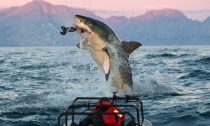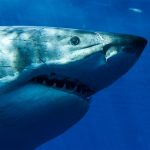
Only a few years ago, scientists estimated there were between 300 and 500 great white sharks in South Africa’s False Bay. Now, they have completely disappeared. While local surfers might have relaxed, the absence of the apex predators is alarming to scientists, and the lucrative industries that rely on their presence.
“I’ve spent my entire life in the field watching these animals on a daily basis,” local cage dive operator and wildlife photographer Chris Fallows says.
“When the waters go quiet, both above and below the surface, and these predators are not there, it sounds huge alarm bells.”
It’s unclear what will happen to marine ecosystems if sharks aren’t there to keep them in check.
Tamlyn Engelbrecht, research manager at local shark safety program Shark Spotters, has been studying shark activity at Seal Island, a rocky outcrop in the middle of the bay.
Home to a colony of over 64,000 Cape fur seals, it’s always been a feeding ground to great whites — famous for “flying” as they breach the surface to attack.
“Already we’ve seen changes in other shark species, such as the bronze whalers and sevengills who have become more prevalent at Seal Island,” she says.
“If it becomes a more long-term knock-on effect, it’s unpredictable what will happen.”
Are a pair of killer whales to blame?
As shark numbers dwindled, fingers were pointed toward a pair of roaming orcas, nicknamed Port and Starboard.
Orcas are known for their specific way of attacking sharks by the pectoral fin and tearing them open to eat the nutritious and buoyant liver.
“You get very intact carcasses with these tell-tale wound marks,” Ms Englebricht explains.
“Two killer whales will come through overnight and the next day you’ll have six, seven or eight carcasses washing up, and those are only the ones that we find.
“A couple of orcas can do quite a lot of damage.”
Mr Fallows is critical of the attention given to the killer whale theory.
“Port and Starboard have a short to medium-term effect, but certainly cannot explain the long-term effect for the complete disappearance of these animals from known global hotspots,” he says.
One of the first cage dive operators in False Bay, he has been putting filmmakers, researchers and tourists into the water with sharks at Seal Island for almost 30 years.
These days, the cage-dive industry attracts 80,000 tourists each year.
But more recently, Mr Fallows has turned his attention — and camera — to South Africa’s demersal longline fishery, which he believes is responsible for the changes in shark populations.
From South African waters to Aussie fish and chips
Demersal longlining targets bottom-dwelling species by laying kilometres of fishing line with several thousand baited hooks across the ocean floor.

The fishery in South Africa specifically targets smaller shark species, known in Australia as gummy and school shark.
The majority of the small sharks caught by South Africa’s demersal fishery are exported to Australia, where they enter our fish and chip market as “flake”.
According to Mr Fallows, these small sharks comprise up to 60 per cent of the diet of great white sharks.
He has been working with South African shark scientist Enrico Gennari to monitor the fishery, which they believe has been poorly managed in recent years in a rush to create jobs.
“South Africa was the first country in the world to protect white sharks. We have been protecting white sharks for 30 years now,” Mr Gennari explains.
“We are risking making that historic decision null and void because we are turning our backs on sustainable use of the resources.
“Protecting a single species, without protecting most of their prey, is obviously not enough.”
Gruesome drone footage taken by Mr Fallows and his team shows the longlining vessels illegally fishing within Marine Protected Areas, and catching endangered hammerhead sharks.
It also shows the fishers beheading and finning sharks on board, in some cases while the sharks are still alive.
By the time they reach land, it is impossible to know whether the meat belongs to targeted or protected species.
“It’s destroying one of the world’s great marine ecosystems, and all for a plate of fish and chips?” Mr Fallows says.
“It doesn’t seem right.”
Earshot reached out to the South African department responsible for this fishery, but did not receive a reply.
What’s really in our ‘flake’?
“Flake” has long been a staple in Australian diets, but overfishing of gummy and school shark populations led to protection of the two species in our waters in the early 1990s.
In order to meet demand, Australia began importing “flake”, mostly from New Zealand and, more recently, from South Africa.
Today, Australia’s gummy shark fishery is considered sustainably managed by the use of strict quotas, or Total Allowable Catch.
In contrast, the demersal longline shark fishery in South Africa is managed by Total Allowable Effort, with the number of permitted vessels currently capped at six. There are no limits, however, on the amount of sharks these six boats are allowed to catch.
Leonardo Guida, a shark expert with the Australian Marine Conservation Society (AMCS), has been working with Mr Gennari and Mr Fallows to analyse species data released by South Africa’s Department of Agriculture, Forestry and Fisheries in late 2019.
“This stock assessment suggests that the school sharks themselves could be commercially extinct before 2055,” Dr Guida explains, “and the smoothhound, they suspect, has dropped by about 40 odd per cent since the early 1990s”.
“It would probably come up as endangered by the global standards.”
Despite South Africa’s current COVID-19 lockdowns, Mr Fallows and Mr Gennari are continuing to campaign through their project Shark Free Chips.
Alongside imploring Australians to choose sustainable seafood, they want the South African government to absorb the demersal shark longlining fishery into South Africa’s larger and more sustainably managed fisheries.
“We want job creation to continue happening by allowing fisheries to carry on, not for five to 10 years, but for decades and more,” Mr Gennari says.
“Failing to do that will mean the South African government will support and promote a fishery which in less than 10 years was able to destroy the incredible coastal shark biodiversity and biomass that made South Africa famous around the world.”
‘We don’t even know if an endangered species is being put on the market’
Australia’s seafood labelling laws require that any fresh or frozen fish sold must be labelled with the country of origin, but once the seafood is cooked, these laws no longer apply.
In many cases, it is impossible to know where or how the fish you’re eating at your local cafe, restaurant or fish and chips shop was caught.
“Australians commonly refer to shark meat as ‘flake’, but it can be sold as ‘pearl fillet’, it can be sold as ‘boneless fillet’ and it can be sold as ‘monkfish’. There’s no legal obligation to actually call it what it is,” Dr Guida says.
With 70 per cent of the seafood we consume in Australia coming from overseas, this poses significant challenges to traceability and accountability, disempowers consumers and impacts Australia’s reputation as a leader in sustainability.
The AMCS has also been following the plight of several endangered species and CITES protected species, traces of which have shown up in pet food and make up products.
“Shark liver has a component called squalene, which is an oil that goes into makeup,” Dr Guida says.
“I mean, for all we know, the now critically endangered scalloped hammerhead from Australian waters could be ending up in makeup — or other endangered species. Who knows?”
According to Dr Guida, while Australian consumers may have little power over overseas fisheries, we do have a responsibility to choose sustainably caught seafood and to push for source of origin species labelling.
“If the retailer doesn’t know, don’t have a go at them, it’s more than likely not their fault,” he says.
“Just become more aware and ask the question.
“On top of that, you can use the AMCS’s Sustainable Seafood Guide. We’ve got green-listed species that we’ve assessed as coming from truly sustainable fisheries, and that look after the broader environmental impacts as well.”















Social Profiles